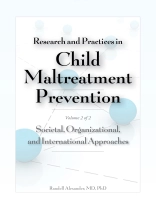430 pages, 30 images, 50 contributors
STM Learning’s Research and Practices in Child Maltreatment Prevention, Volume 2: Societal, Organizational, and International Approaches provides in-depth examinations of prevention models across social spheres. This comprehensive second volume includes chapters on the roles of community, corporate business, government, nonprofits, and research organizations in child abuse prevention.
Written by and for multidisciplinary professionals in medicine, law, social work, and public health, this all-new title is a vital resource for those working to prevent child abuse in all its forms. Readers across fields will benefit from an expansive collection of studies in the most up-to-date best practices in child abuse prevention and child safety.
Tabela de Conteúdo
SECTION I: COMMUNAL AND SOCIETAL PREVENTION
1. Preventing Child Maltreatment Through the Positive Community Norms Framework
2. The Power of Child Death Review to Prevent Maltreatment
3. Business: Increasing Involvement
4. Prevention Advocacy and Legislation
SECTION II: AGENCY AND ORGANIZATIONAL APPROACHES TO PREVENTION
5. Preventing Child Maltreatment United States Military Community
6. The Federal Government’s Role in Child Maltreatment Prevention: History and Current Efforts
7. National Organizations Preventing Child Abuse and Neglect Before They Occur
8. Children’s Advocacy Centers and Child Abuse Prevention: A Natural Fit
SECTION III: SELECTED MODELS OF PREVENTION
9. Early Home Visitation Services to Prevent Physical Child Abuse and Neglect
10. Strengthening Families Through Early Care and Education
11. Maltreatment Prevention Programming in Early Childhood: A Review of Models Delivered in Center-Based Settings
12. Shared Leadership®: An Innovative Approach to Child Abuse and Neglect Prevention
13. The PREVENT Program: A Public Health Approach
14. A Population Approach to the Prevention of Child Maltreatment: The Triple P—Positive Parenting Program System
15. Safe Care®: Preventing Child Neglect Through Scaling-Up and Examining Implementation Issues of an Evidence-Based Practice
SECTION IV: PREVENTION AMONG SPECIAL POPULATIONS
16. The Prevention of Maltreatment Among Children With Disabilities Through Early Identification and Comprehensive Provision of Services
17. Cultural Considerations in Prevention of Child Abuse and Neglect
SECTION V: INTERNATIONAL APPROACHES TO PREVENTION
18. Children’s Rights to Prevention of and Protection From Violence and Maltreatment
19. Sure Start Local Programmes: Area-Based Preventative Intervention in England
20. Child Abuse Prevention in Canada
21. Child Abuse Prevention and Neglect Prevention: The Pakistani Scenario
22. Prevention of Child Abuse in Estonia
SECTION VI: CONCLUSION
23. The Future of Child Abuse Prevention
Sobre o autor
Randell Alexander is a professor of pediatrics at the University of Florida and the Morehouse School of Medicine. He currently serves as chief of the Division of Child Protection and Forensic Pediatrics and interim chief of the Division of Developmental Pediatrics at the University of Florida-Jacksonville. He is the statewide medical director of child protections teams for the Department of Health’s Children’s Medical Services and is part of the International Advisory Board for the National Center on Shaken Baby Syndrome. He has also served as vice chair of the US Advisory Board on Child Abuse and Neglect, on the American Academy of Pediatrics Committee on Child Abuse and Neglect, and the boards of the American Professional Society on the Abuse of Children (APSAC) and Prevent Child Abuse America. He is an active researcher, lectures widely, and testifies frequently in major child abuse cases throughout the country.












